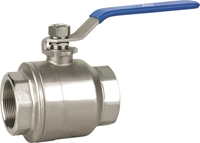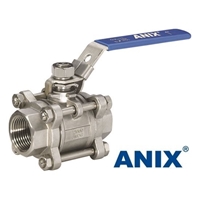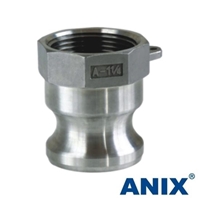If you are looking for a reliable valve wholesaler and supplier, please visit Anix's line of products here
The system used to control or regulates the flow or pressure of liquids or gases is known as valve or high pressure valve. It’s operated by closing, opening or turning the handles fitted on it. Most commonly, this system is used in pipe fittings, where the fluid runs from higher pressure towards the lower.

Body and bonnet are the principle components of the valve which holds the liquid passing through it. The bonnet is called casing. This casing is usually made up of the bronze, brass, iron and alloys of steel.
The high pressure valves are utilized in power generation, oil and gas industry, mining, sewerage and in all these areas where pipe fittings are used. It’s a needed part of plumbing in the shape of hot and cold taps. Heavy valves are used in gas industry to manage the pressure of gas while tiny valves are fitted in cooker, dishwashers and different small domestic machines. Ports are fitted in it to manage the flow of liquid. Valves may have 2 until 20 ports. It’s linked with pipes.
High pressure valves are operated in quite a lot of ways, either manually, by a hand wheel, or with some lever. Automatic valves are commonly utilized in industry which is operated by the computers. Safety valves are important a part of boilers which might be operated by the change of strain or temperature of the fluid.
Types of Valves
Valves play very important function in Otto cycle engines where tappets or pushing rods drive these valves. Valves are available in nearly all sizes which vary from 0.1 mm till 2 ft, while some heavy valves could exceed their diameter greater than four or 5 meters.
Disposable valves are inexpensive while the specialized valves may cost in 1000’s of dollars according to their sizes. Disposable valves are mostly used in house hold utensils as water dispenser or in mini pump.
Duplex ball valve works with out pressure drop. It’s best for fast shut off as it shuts off at a turn of 900 while different valves require the multiple turns to shut off.
Hastelloy examine valve is utilized in oil and gas wellheads which raises or lowers a cylinder placed inside the other cylinder.
Stainless-steel gate valves are used for a smooth flow of fluid. These are also used to manage the liquid which carries solids in suspension.

Competitive ball valve suppliers are providing high pressure valves, which are useful for the consumers. These suppliers specifically deal in ball valve, mechanical valve and high pressure valves. Some ball valve suppliers are dealing in floating valves, Tee ball valves, flexible and fixed ball valves as per choice of the customer. The ball valve provider additionally deals in ceramic disc valves used to perform high duty applications or for rough fluids. Its disc provides a leakage seat. The check valve inside it regulates the flow of water to run in a single direction only. Ball valve has a soft seat and it has less possibilities of leakage when it’s turn off while the hard seated valves as glob, gate or check valves have maximum durability.
When you have your water heater serviced, one thing the plumber may do is check the safety valve on the tank. This valve should always be operational so pressure can bleed off. This is a safety measure that keeps the tank from rupturing or exploding. You should also check the valve occasionally to make sure it's working and call a plumber to replace the valve when it's damaged or broken. Here are some things to know about the pressure valve on your hot water heater.
What Causes A Pressure Relief Valve To Go Bad
One common problem with these valves is they can become clogged with scale buildup and sediment from inside the tank. This might cause the valve to leak or clog off. Also, the valve may just wear down due to age, or a part might break when you're flipping the valve to test it. When the valve has trouble, you may notice it dripping water constantly. Water that gushes out is a serious sign of trouble with either the valve or the tank, and the tank should be shut down to relieve the pressure.
Another sign of valve trouble is when it makes a whistling noise. This means steam is escaping through the valve. When your tank has unusual noises coming from it, it's always good to call a plumber to check for problems such as increased pressure or sediment buildup.
How To Check The Pressure Valve
You may want to check the valve once or twice a year to make sure it's still working as it should. If you notice the valve dripping occasionally, it's probably doing its job of releasing pressure. Just check again the next day to see if the dripping has stopped. When you test the valve, move the lever back and forth to open and close it. When you open the valve, water should flow out the end of the attached pipe. If it doesn't, call a plumber to repair the valve because it might be clogged with corrosion.
Sometimes, when you open the valve to test it, sediment gets stuck in the valve and it won't shut back off. When this happens, you may need to call in a plumber if the dripping doesn't stop after you've moved the lever back and forth a few times.
How A Bad Valve Is Replaced
Replacing a bad valve involves turning off the power supply to the tank and letting some of the water drain out until the level is below the valve. The pipe attached to the valve is taken off, and sometimes it might be necessary to cut it off. Then, the valve is unscrewed, which can sometimes be difficult if it is frozen tight with sediment and corrosion buildup. With the old valve out of the way, a new one can be screwed in and a drain pipe attached. Finally, the new valve is tested for proper operation.
Sometimes, when a pressure relief valve acts up, it's not because something is wrong with the valve, but because of other problems with the plumbing or water heater. In that case, your plumber may need to make other repairs on your system to solve pressure problems in the tank.



